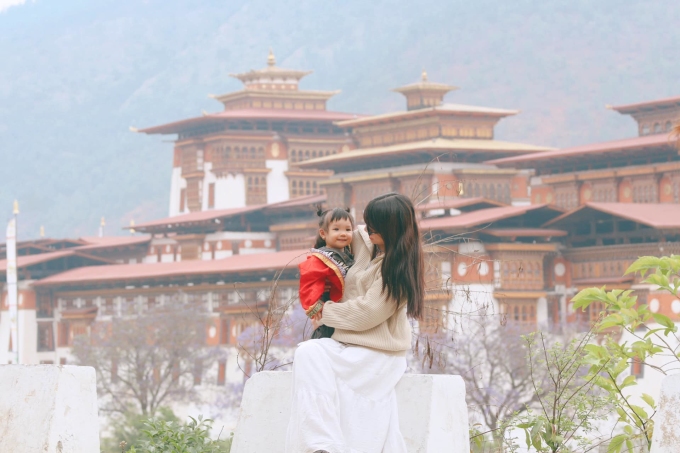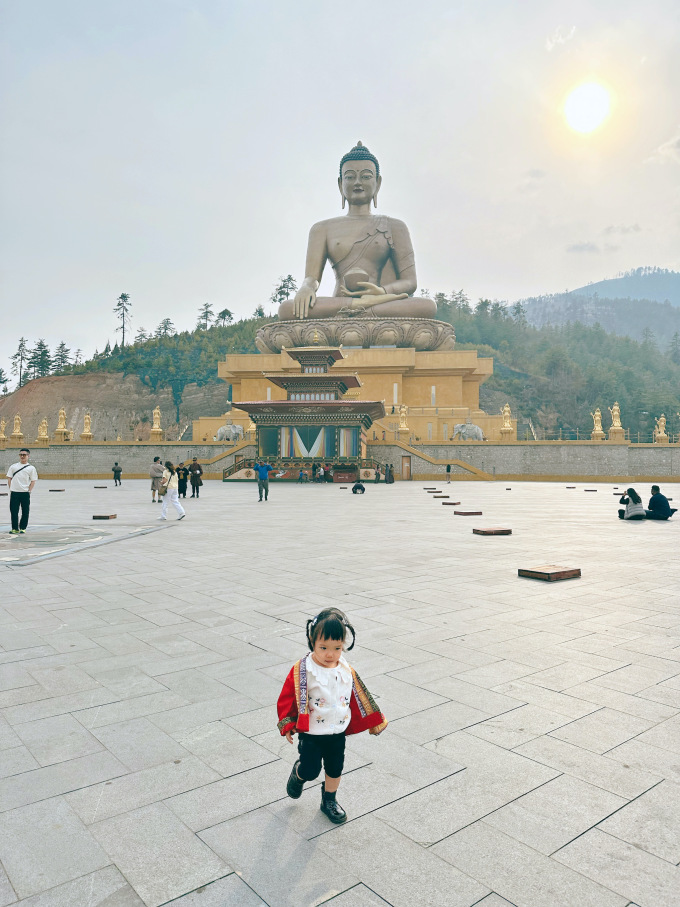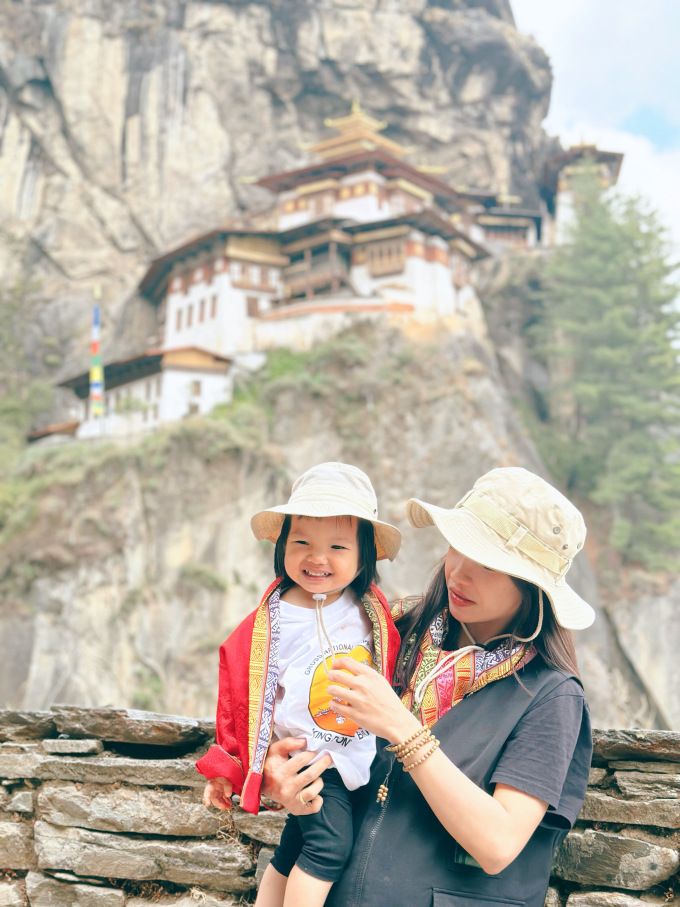A Vietnamese female tourist shared that the itinerary for the sightseeing spots in Bhutan is quite similar, and the choice of accommodation will determine the overall cost of the trip. A 3-star hotel package costs 55 million VND per person, a 4-star hotel is 68 million VND, and a 5-star hotel is 76 million VND for a 4-night stay. The tour package includes a tourism fee or sustainable development fee of 100 USD per day, collected by the Bhutan government.

Ms. Phuong Nam and her daughter visited Punakha Dzong, a fortress in Punakha surrounded by blooming purple flame trees.
Ms. Nam opted for a direct charter flight with business-class seats and 5-star accommodation to ensure the well-being of the young family member and allow the whole family to have ample relaxation and exploration time. The flight and accommodation cost 85 million VND per person, with the infant paying approximately 30%, amounting to 25.5 million VND.
Direct charter flights to Bhutan are rare, and Drukair Royal Bhutan Airlines only offers 1-2 flights per year, which are more expensive than connecting flights. The flight time is approximately 4 hours.
According to Ms. Nam, traveling to Bhutan is costly, but the visa application process is straightforward. Tourists only need to apply for an e-visa and submit their application at least 72 hours before departure. The tour company will handle the paperwork, and travelers only need to prepare the required documents.
Ms. Nam and her husband chose Bhutan instead of amusement parks, wanting their child to experience a new place, witness sunrises and sunsets behind mountain ranges, be surrounded by trees and pristine forests, and enjoy wildflowers along the roads, blooming apple orchards, and vibrant rhododendron forests. She believes that these are “experiences that children born in urban areas may not always have the opportunity to behold.”
The trip to Bhutan was also a chance for the family to immerse themselves in the country’s philosophy of happiness. Ms. Nam asked the local guide, Khankar, “Why is Bhutan considered a happy country, and are you personally happy and content?”
Khankar replied that everyone seeks happiness for themselves and their loved ones. In Bhutan, he is fortunate to have access to free healthcare and education and to consume organic food. The people around him are also amicable.

Ms. Nam Phuong’s 19-month-old daughter at Buddha Point (Kuensel Phodrang), overlooking the Thimphu valley.
There are three main tourist destinations in Bhutan: the cities of Paro, Thimphu, and Punakha. These locations are 50-115 km apart, and the winding mountain roads can cause motion sickness. While the tour program is fixed, tourists can choose to follow the entire itinerary or skip some spots, depending on their health condition. Families with young children who are prone to illness should avoid visiting too many places.
During their 5-day stay in Bhutan, Ms. Nam’s family visited all three cities: Paro, Thimphu, and Punakha, exploring famous tourist spots. In Thimphu, they visited the Royal Takin Preserve and witnessed the sunset at Buddha Point, the largest sitting Buddha statue in the world. In Punakha, they explored the Punakha Dzong fortress and the Punakha suspension bridge. In Paro, they embarked on a journey to Tiger’s Nest, a Buddhist monastery perched atop a 3,000-meter-high cliff, famous in the Land of the Thunder Dragon.
“My baby was the youngest member on the charter flight to Bhutan and the only infant to visit Tiger’s Nest,” shared Ms. Nam.
The female traveler attributed the smooth journey with her young child to thorough preparation. Firstly, she ensured they had the necessary identification documents, including birth certificates, passports, and e-visas. Secondly, she packed essential medications such as fever reducers, motion sickness pills, stomachache remedies, nasal drops, nasal sprays, and vitamin C. Anticipating her child’s potential fussiness with food, she brought along chewy candies, chocolate, snacks, rice crackers, dried yogurt, and rice cakes to offer during their travels. Additionally, given the cold weather in Bhutan, she packed warm clothing, hats, sunscreen, and outdoor activity gear, including shoes.
Ms. Nam noted that the food in Bhutan tends to be spicy and greasy due to the prevalent use of chilies and cheese. She recommended that parents bring extra instant porridge, soup, and milk for their children. However, she assured that the vegetables, fruits, and organic produce in Bhutan are safe and delicious for children to enjoy.
The 5-day journey to Bhutan provided Ms. Nam with insights into the country. She observed that in large cities like Thimphu, there were no tall buildings, traffic lights, traffic jams, or blaring horns. The locals highly value their traditions and wear their national dress daily. They also embrace a green lifestyle, as 72% of their living environment is covered by pristine forests. The government is committed to reducing greenhouse gas emissions.

Ms. Nam Phuong and her daughter at the Tiger’s Nest monastery.
The people of Bhutan work just enough to sustain their basic needs, embracing a slower pace of life, deep breathing, a love for nature, and a profound appreciation for every forest, river, flower, and blade of grass. Ms. Nam believes that the happiness of each individual in Bhutan contributes to the country’s overall happiness.
“There are a thousand reasons to praise Bhutan, and each person will paint their own picture of happiness in this enchanting land,” Ms. Nam concluded.






























